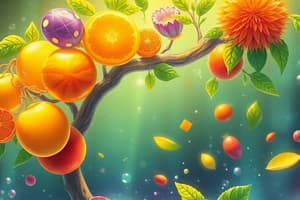Podcast
Questions and Answers
What is the process by which ADP is converted to ATP using the energy of sunlight?
What is the process by which ADP is converted to ATP using the energy of sunlight?
- Cyclic phosphorylation
- Photophosphorylation (correct)
- Noncyclic phosphorylation
- Photolysis
Which process involves the splitting of the water molecule into oxygen and hydrogen protons?
Which process involves the splitting of the water molecule into oxygen and hydrogen protons?
- Photophosphorylation
- Noncyclic phosphorylation
- Photolysis (correct)
- Cyclic phosphorylation
Which photosystem performs cyclic phosphorylation?
Which photosystem performs cyclic phosphorylation?
- PSII
- PSIV
- PSIII
- PSI (correct)
Which photosystem performs noncyclic phosphorylation?
Which photosystem performs noncyclic phosphorylation?
Why is cyclic photophosphorylation thought to provide additional ATP required for carbohydrate synthesis?
Why is cyclic photophosphorylation thought to provide additional ATP required for carbohydrate synthesis?
What is the initial step in cyclic photophosphorylation after the absorption of light by PSI?
What is the initial step in cyclic photophosphorylation after the absorption of light by PSI?
What is the role of cytochrome b 6f in cyclic photophosphorylation?
What is the role of cytochrome b 6f in cyclic photophosphorylation?
What is the movement of electrons during the formation of oxygen called?
What is the movement of electrons during the formation of oxygen called?
What is the process by which protons are translocated to form a gradient utilized for ATP synthesis in cyclic photophosphorylation?
What is the process by which protons are translocated to form a gradient utilized for ATP synthesis in cyclic photophosphorylation?
What is the role of plastocyanin in cyclic photophosphorylation?
What is the role of plastocyanin in cyclic photophosphorylation?
What is the process by which ATP is generated from a proton gradient in cyclic photophosphorylation?
What is the process by which ATP is generated from a proton gradient in cyclic photophosphorylation?
Which process involves the production of only ATP and no oxygen?
Which process involves the production of only ATP and no oxygen?
What is the key enzyme in the Calvin Cycle?
What is the key enzyme in the Calvin Cycle?
In which part of the chloroplast does the Calvin Cycle occur?
In which part of the chloroplast does the Calvin Cycle occur?
Which type of plants use a pathway involving the production of 4-carbon compounds for carbon fixation?
Which type of plants use a pathway involving the production of 4-carbon compounds for carbon fixation?
Which plants have a photosynthetic adaptation that allows them to take up $CO_2$ at night to minimize water loss during the day?
Which plants have a photosynthetic adaptation that allows them to take up $CO_2$ at night to minimize water loss during the day?
Which plants use the Calvin Cycle for carbon fixation?
Which plants use the Calvin Cycle for carbon fixation?
What is the source of electrons in noncyclic phosphorylation?
What is the source of electrons in noncyclic phosphorylation?
Which type of phosphorylation involves both Photosystem I and Photosystem II?
Which type of phosphorylation involves both Photosystem I and Photosystem II?
What is the product of carbon dioxide fixation in the Calvin Cycle?
What is the product of carbon dioxide fixation in the Calvin Cycle?
Which plants have additional pathways to minimize water loss and efficiently use $CO_2$?
Which plants have additional pathways to minimize water loss and efficiently use $CO_2$?
What is the electron source in cyclic phosphorylation?
What is the electron source in cyclic phosphorylation?
Which plants use a pathway involving the production of 4-carbon compounds for carbon fixation?
Which plants use a pathway involving the production of 4-carbon compounds for carbon fixation?
During cyclic photophosphorylation, what is the initial step after the absorption of light by PSI?
During cyclic photophosphorylation, what is the initial step after the absorption of light by PSI?
What is the role of cytochrome b 6f in cyclic photophosphorylation?
What is the role of cytochrome b 6f in cyclic photophosphorylation?
Which type of phosphorylation is thought to provide additional ATP required for carbohydrate synthesis?
Which type of phosphorylation is thought to provide additional ATP required for carbohydrate synthesis?
What is the movement of electrons during the formation of oxygen called in noncyclic photophosphorylation?
What is the movement of electrons during the formation of oxygen called in noncyclic photophosphorylation?
What is the primary product of noncyclic phosphorylation in photosynthesis?
What is the primary product of noncyclic phosphorylation in photosynthesis?
What is the specific electron source used in cyclic phosphorylation in photosynthesis?
What is the specific electron source used in cyclic phosphorylation in photosynthesis?
What is the key enzyme in the Calvin Cycle, essential for carbon fixation?
What is the key enzyme in the Calvin Cycle, essential for carbon fixation?
Where does the Calvin Cycle occur within the chloroplast?
Where does the Calvin Cycle occur within the chloroplast?
Which type of plants use the Calvin Cycle for carbon fixation?
Which type of plants use the Calvin Cycle for carbon fixation?
Which plants use a pathway involving the production of 4-carbon compounds for carbon fixation?
Which plants use a pathway involving the production of 4-carbon compounds for carbon fixation?
Which plants have a photosynthetic adaptation to minimize water loss during the day?
Which plants have a photosynthetic adaptation to minimize water loss during the day?
What is the primary product of carbon dioxide fixation in the Calvin Cycle?
What is the primary product of carbon dioxide fixation in the Calvin Cycle?
Which plants have structural and biochemical differences that affect their ability to grow in hot and dry climates?
Which plants have structural and biochemical differences that affect their ability to grow in hot and dry climates?
What is the primary function of the cyclic phosphorylation in photosynthesis?
What is the primary function of the cyclic phosphorylation in photosynthesis?
What is the primary function of noncyclic phosphorylation in photosynthesis?
What is the primary function of noncyclic phosphorylation in photosynthesis?
What is the specific compound used as the electron source in noncyclic phosphorylation?
What is the specific compound used as the electron source in noncyclic phosphorylation?
Flashcards are hidden until you start studying
Study Notes
Photosynthesis and Carbohydrate Synthesis in Plants
- Photosynthesis involves two types: cyclic phosphorylation and noncyclic phosphorylation
- Noncyclic phosphorylation involves both Photosystem I (PSI) and Photosystem II (PSII) and uses water as the source of electrons, leading to the production of NADPH, ATP, and oxygen
- Cyclic phosphorylation specifically involves Photosystem I and uses P700 as the electron source, producing only ATP and no oxygen
- Carbon dioxide fixation and carbohydrate synthesis occur in the Calvin Cycle, involving carboxylation of Ribulose 1,5 bisphosphate (RuBP), reduction of PGA to form glyceraldehyde 3-phosphate (GAP), and regeneration of RuBP
- The key enzyme in the Calvin Cycle is ribulose bisphosphate carboxylase oxygenase (Rubisco), which fixes approximately 3 molecules of CO2 per second
- The Calvin Cycle occurs in the stroma of chloroplasts and is essential for the production of glucose and other organic molecules
- C3 plants, such as wheat and rice, use the Calvin Cycle for carbon fixation, while C4 plants, like maize and sugarcane, use a pathway involving the production of 4-carbon compounds
- CAM plants, including cacti and orchids, have a photosynthetic adaptation that allows them to take up CO2 at night to minimize water loss during the day
- C3, C4, and CAM plants have structural and biochemical differences that affect their ability to grow in hot and dry climates
- C3 plants use the Calvin Cycle for carbon fixation, while C4 and CAM plants have additional pathways to minimize water loss and efficiently use CO2
- The differences in photosynthesis and carbohydrate synthesis in C3, C4, and CAM plants allow them to adapt to different environmental conditions
- Photosynthesis is not universal in all plants, and different types of plants have evolved different mechanisms for carbon fixation and carbohydrate synthesis based on their environmental conditions
Photosynthesis and Carbohydrate Synthesis in Plants
- Photosynthesis involves two types: cyclic phosphorylation and noncyclic phosphorylation
- Noncyclic phosphorylation involves both Photosystem I (PSI) and Photosystem II (PSII) and uses water as the source of electrons, leading to the production of NADPH, ATP, and oxygen
- Cyclic phosphorylation specifically involves Photosystem I and uses P700 as the electron source, producing only ATP and no oxygen
- Carbon dioxide fixation and carbohydrate synthesis occur in the Calvin Cycle, involving carboxylation of Ribulose 1,5 bisphosphate (RuBP), reduction of PGA to form glyceraldehyde 3-phosphate (GAP), and regeneration of RuBP
- The key enzyme in the Calvin Cycle is ribulose bisphosphate carboxylase oxygenase (Rubisco), which fixes approximately 3 molecules of CO2 per second
- The Calvin Cycle occurs in the stroma of chloroplasts and is essential for the production of glucose and other organic molecules
- C3 plants, such as wheat and rice, use the Calvin Cycle for carbon fixation, while C4 plants, like maize and sugarcane, use a pathway involving the production of 4-carbon compounds
- CAM plants, including cacti and orchids, have a photosynthetic adaptation that allows them to take up CO2 at night to minimize water loss during the day
- C3, C4, and CAM plants have structural and biochemical differences that affect their ability to grow in hot and dry climates
- C3 plants use the Calvin Cycle for carbon fixation, while C4 and CAM plants have additional pathways to minimize water loss and efficiently use CO2
- The differences in photosynthesis and carbohydrate synthesis in C3, C4, and CAM plants allow them to adapt to different environmental conditions
- Photosynthesis is not universal in all plants, and different types of plants have evolved different mechanisms for carbon fixation and carbohydrate synthesis based on their environmental conditions
Studying That Suits You
Use AI to generate personalized quizzes and flashcards to suit your learning preferences.




